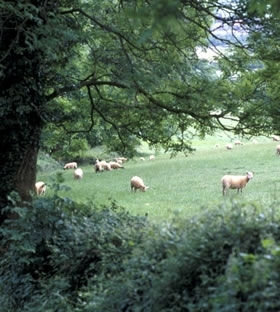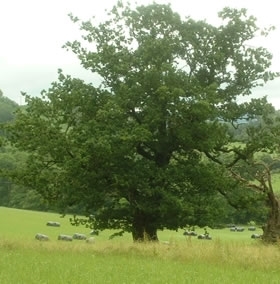 By Holly Howe, Communications Assistant
By Holly Howe, Communications Assistant
The policy and practice of agroforestry, deliberately integrating trees or shrubs with crop and/or animal systems, is becoming increasingly of interest to farmers in the UK. The GWCT is participating in a project involving this system and we look forward to updating you as it progresses.
In terms of the importance of agroforestry, think of some sheep on a farm. Chances are you’re imagining a lush green field, surrounded by hedge. If you’re in Wales or Scotland there is probably the odd rock and tree too. Now think of an animal in a wood.
You’ve probably got a deer or squirrel in mind. Perhaps birds. You may also be thinking of an invertebrate or two, hiding away in the shelter of a rotting log.
But if you live in parts of Scandinavia or Greece, for example, sheep and forests very much go hand in hand. Livestock have long been grazed in wooded pastures in a system known as agroforestry.
Here in the UK, farmers are starting to explore tree planting with interest, spurred on by recent devastating flooding that has had a massive impact on livelihoods. Woods, trees and hedgerows can play a key role in water management whether reducing flood risk, improving water quality or helping freshwater wildlife thrive and survive.
 Trees can help a farm diversify; producing wood fuel and timber; and in some cases an extra crop like apples. Livestock may benefit from browsing the leaves and from finding shade and shelter under tree canopies, which act as natural windbreaks.
Trees can help a farm diversify; producing wood fuel and timber; and in some cases an extra crop like apples. Livestock may benefit from browsing the leaves and from finding shade and shelter under tree canopies, which act as natural windbreaks.
The shelter they provide reduces exposure potentially lowering the incidence of neonatal lamb losses, and mastitis in ewes. Improved drainage means better underfoot conditions. And trees planted near streams and wet areas can keep livestock away from waterlogged ground, where liver fluke thrives.
Trees and hedges can also provide nectar sources for pollinators, providing added benefit for arable crops in neighbouring areas.
Although the advantages are considerable, some farmers are concerned about trees taking productive land out of use and the shading of crops. But with specialist advice, the right trees in the right place can be integrated into farming plans and help increase productivity as well as make the farm more resilient to increasingly frequent extreme weather events.
If you are thinking of planting more trees, whether a land manager or farmer, just remember to focus on the UK native species. Dutch elm disease and ash dieback disease are both suspected to have been caused by imported non-native stock. In addition, UK native tree species will be more suited to our environmental conditions and will be more suitable for supporting our wildlife.
The GWCT is able to advise on all aspects of woodland management.
For more information for farmers on how to integrate trees into farmland for maximum benefit, you may like to contact the Woodland Trust. They can provide subsidised trees, on-farm assessments and bespoke planting schemes as well as much more.
 Free weekly newsletter
Free weekly newsletter
Stay updated and get all the latest GWCT blog updates and news delivered straight to your inbox each week.
Sign up FREE to the Weekly GWCT Newsletter >